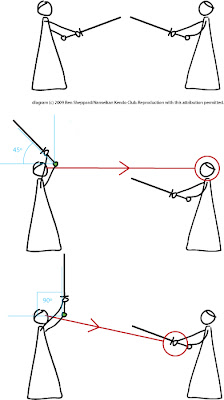Vision vs Muscle Memory: how to hit the target every time
the characters mu (nothingness) so (thought) and ken (sword)
Today when we were practicing suriage waza, and in particular the very difficult technique of kote-suriage kote, the issue of targeting came up. Targeting is the way you aim for, and hit, a target.
Usually we think of our eyes a being the main way of perceiving the target: we look for the target, and via the mysterious ability of the brain to orient the body in space (kinesthesis) we launch forwards and hit the target of our choice. However in Kendo there are two things that make this a bit of a problem.
Your eyes tell you, and your opponent, too much
Firstly, if you look at your opponent's kote, then your opponent will see the direction of your gaze and they will know where you will strike before you act. In short, by looking you give away your intention.
Secondly, in Kendo there are some situations where the information you get from your eyes can be a hindrance more than a help.
The first of these situations is whenever you strike kote in particular. Because of the angle of your opponent's kote when they are in kamae, our instinct is to adjust the angle of our cut to land perpendicular to the target. This, we feel, would surely give us the best chance of success. But what usually happens is we strike either the kobushi (fist) or their tsuba. Furthermore, the action of cutting in from the side leads to a weaker cutting action that is harder to control and target accurately hence to a lower success rate.
This is in spite of all the kihon training we do where we practice kote as being straight up and down, the same as shomen. It's as if we just can't quite believe that this way could work. The size of the kote's target area (datotsubui) is indeed smaller when seen front-on compared to if we sneak around to the left of our opponent's kensen. So we make small, last-minute adjustments to the path of our kote cut, hoping it will lead to success. We never think that it is these adjustments, based on the evidence of our eyes and our sense of logic, that might be the reason we keep missing the target.
The second of these problems is that visual targeting, where you wait to see what is happening and think about what you have seen before finally making a decision to act, is often too slow to take advantage of the fleeting opportunities to strike in Kendo. This process is known in modern military strategy as the OODA loop. OODA stands for "Observe, Orient, Decide, Act". This loop can happen rapidly, but in Kendo I would argue it is never quite rapid enough. Perhaps a Kendo version would be the OOA loop!
Muscular memory and mu-so-ken
To return to the problem of being able to strike a small target area consistently, the best way to do this is not to use your eyes. Of course your eyes are still necessary and you can't help but use them. However the feeling you should have is that you are not using them. Gaze at your whole opponent without looking at anything in particular. Take in only general visual information, don't be specific. If you want to cut kote, don't look at kote.
The first thing to do is be aware of ma-ai. In chudan no kamae this is done largely by touch, using your kensen. Once you are at your uchima (striking distance), the muscular memory you have developed from dozens if not hundreds of repetitions of kihon waza, should be accessed. In other words: Observe, Orient, Act! Don't make a decision, and don't use any discrimination (thinking about this-or-that) or calculations ("five degrees to the left will give me enough space to get around...").
A word should be said here about orienting yourself. This is done by making sure your hara (centre) is aiming straight at your opponent. Both your feet should be pointing straight at them, and in every way you should move in exactly the same way you have practiced during the most basic drills. If your orientation is right, and your ma-ai is right, then you will strike the target area, even though you have not checked with your eyes exactly where the target is. The more you learn to strike in this way, the more confident and consistent you will become. Those at training today saw how incredibly consistent this approach is: it not only leads to you striking the target area every time, it may even allow you to strike the exact same spot on the target every time.
This is part of the meaning of the phrase mu-so-ken, or "no thought sword". It is trusting that your sword will move to where it should, and letting it do so without hindrance.


Comments